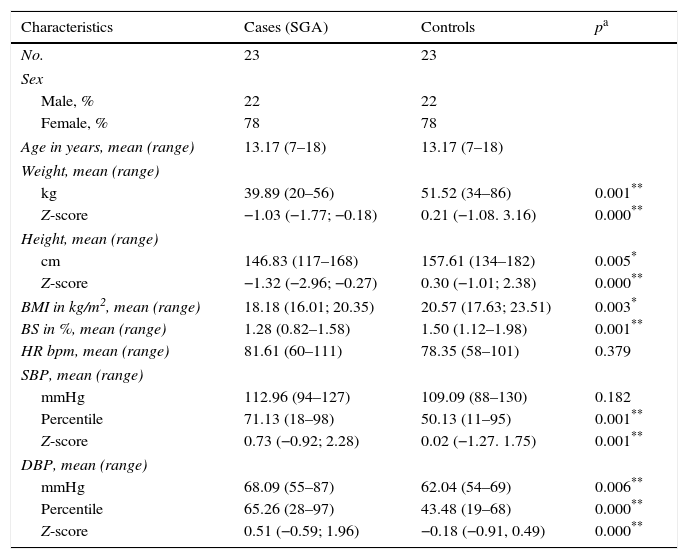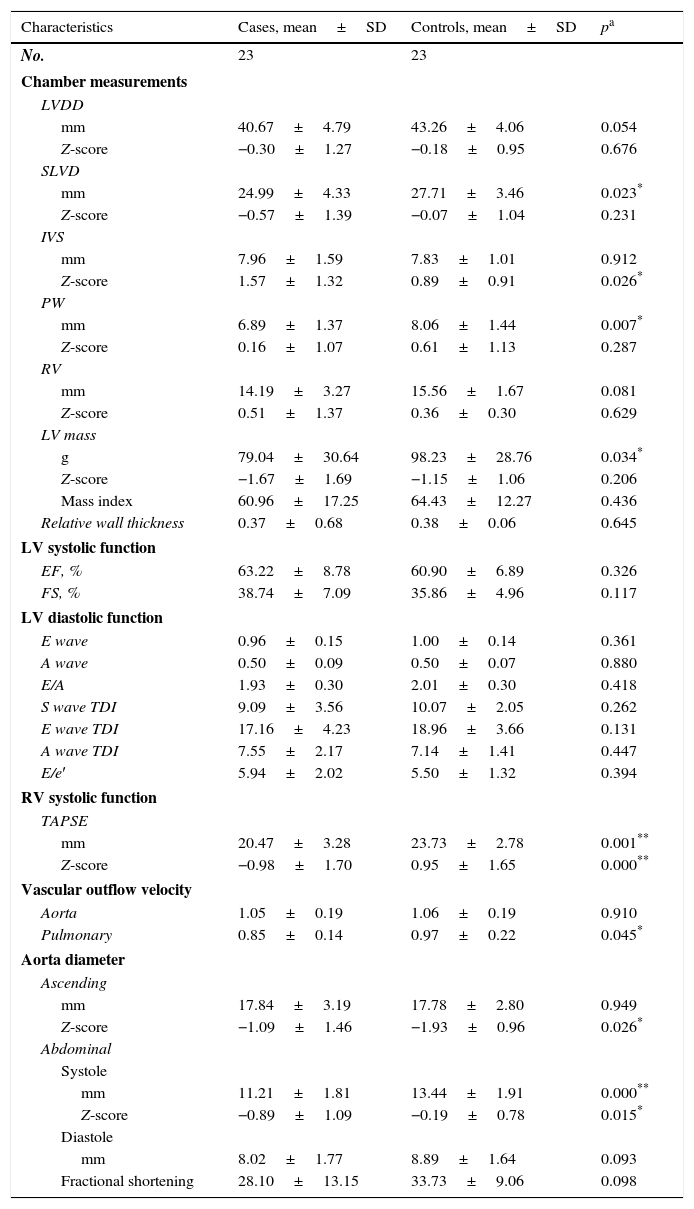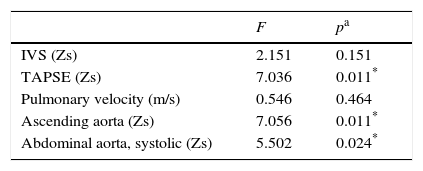Small for gestational age (SGA) patients have an increased risk of developing a cardiovascular pathology, as well as a metabolic syndrome. Our objective is to evaluate the cardiac morphology and function of SGA children treated with growth hormone (GH), identifying changes that could potentially have long-term consequences.
MethodsWe selected 23 SGA school-age patients and 23 healthy children. We measured their weight, height, blood pressure and heart rate. Using transthoracic echocardiography, we evaluated cardiac chamber size, ascending and abdominal aortic diameter as well as the systolic and diastolic function of both ventricles.
ResultsSGA children have a higher systolic and diastolic blood pressure (p<.05) without significant changes in their heart rate. They also have a thicker interventricular septum (SGA Z-score 1.57 vs. 0.89; p=.026) and a worse right ventricular systolic function, with a lower TAPSE (SGA Z-score −0.98 vs. 0.95; p=.000), as well as a lower blood flow rate in the pulmonary artery (SGA 0.85m/s vs. 0.97m/s; p=.045). No significant difference was observed in the patients’ left ventricular function. SGA patients’ ascending aortic diameter was greater (SGA Z-score −1.09 vs. −1.93; p=.026), whereas the systolic abdominal aortic diameter was smaller (SGA Z-score−0.89 vs. −0.19; p=.015).
ConclusionsWe found functional and morphological cardiac changes in SGA school-age patients treated with GH. It is important to follow-up this patient group in order to determine if these changes contribute to an increased cardiac morbidity in adulthood.
Los pacientes pequeños para la edad gestacional (PEG) son población de riesgo para el desarrollo de enfermedad cardiovascular y síndrome metabólico. Nuestro objetivo es estudiar la morfología y la función cardiaca en un grupo de niños PEG en edad escolar en tratamiento con growth hormone (GH, «hormona de crecimiento»).
MétodosSe han incluido en el estudio 23 pacientes PEG y 23 controles sanos. Se valoró peso, talla, presión arterial y frecuencia cardiaca. Mediante ecocardiografía transtorácica se evaluó el tamaño de las cavidades cardiacas, el diámetro de la aorta ascendente y abdominal y parámetros de función biventricular.
ResultadosLos niños PEG presentan mayores percentiles de presión arterial sistólica y diastólica (p<0,05), sin cambios significativos en la frecuencia cardiaca. Tienen un mayor diámetro del septo interventricular (Z-score 1,57 en PEG frente a 0,89; p=0,026) y una peor función sistólica del ventrículo derecho, con un TAPSE inferior (Z-score −0,98 en PEG frente a 0,95; p=0,000) y una menor velocidad sanguínea en arteria pulmonar (0,85m/s en PEG frente a 0,97m/s; p=0,045). No se han encontrado diferencias en la función del ventrículo izquierdo. El diámetro de la aorta ascendente es mayor en PEG (Z-score −1,09 frente a −1,93; p=0,026), mientras que el diámetro de la aorta abdominal en sístole es menor (Z-score −0,89 frente a −0,19; p=0,015).
ConclusionesSe han observado cambios significativos en la morfología y la función cardiaca en niños PEG en edad escolar tratados con GH. Es importante continuar en ellos un seguimiento para determinar si estas alteraciones contribuyen a un aumento de morbilidad cardiaca en la edad adulta.











